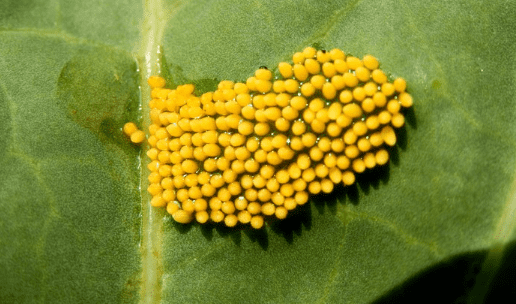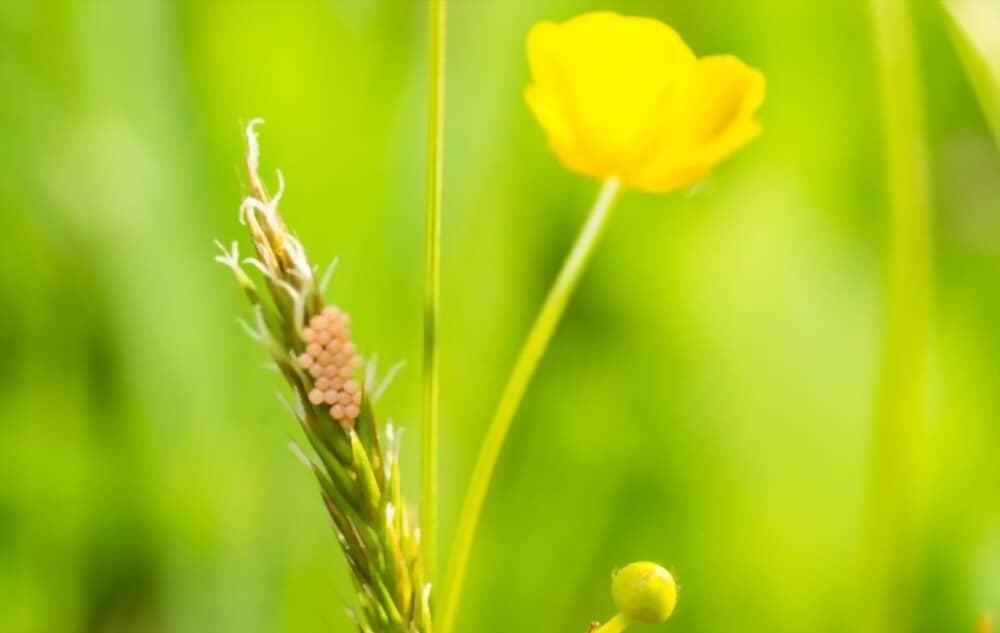
Insects will lay their eggs on the upper and lower surfaces of plant leaves in order to provide protection and a food source for the developing larvae.
The eggs of moths, beetles, aphids, and stink bugs can all be identified among the yellow ones seen on plant leaves. When first laid, the eggs may have a pale yellow color, which can vary with time. The health of the plant as a whole will be impacted if the larvae are allowed to hatch and feed on the leaves until they are mature.
Seeing insect eggs on plant leaves might be unsettling, but accurate identification will help you decide whether to leave or take action to remove the eggs from the leaves.
We’ve talked about the many bug species that lay eggs on leaves and what you can do if you see that they are damaging to the plant.
Table of Contents
What Insects Lays Eggs on leaves?
Species differences affect the shape, size, and color of insect eggs. For instance, gelatinous, keg-shaped, and bullet-shaped.
Eggs can be placed alone, in groups, or in clusters. The quantity is determined by the likelihood of predation that the larvae will experience.
Some beetle species produce enormous batches of several thousand eggs because only some will survive to adulthood.
The larvae can assault the plant after hatching and feed on the nearby structure until they reach a mature stage where they can travel.
At that moment, the damage would have have been done, which could sometimes result in the plant’s death.
List of insects that lay yellow eggs on leaves:
Moth Pests:
Many moth species, many of which are pests of either crops or vegetable gardens—or both—have yellow eggs.
On the top surface of the leaves, these insects frequently deposit their eggs.
Beetle Pests:
The narrow, grey or yellow stripes on these delicate insects are frequently black or grey in color. On the undersides of leaves, these insects deposit clusters of around 20 eggs.
Aphids:
Aphids commonly wreak havoc on roses and other attractive plants, stunting the growth.
These insects have been found to lay their eggs on both the lower and higher ends of leaves, according to research.
Lady beetle:
These spherical predators cover the undersides of leaves with swarms of oval, bright yellow eggs.
Armyworms:
They are adults in their adult state and a very frequent vegetable warm. By depositing eggs on blossoms and foliage, the brownish-gray moths harm plants.
Their larva is more harmful since it eats plant tissues while boring holes in the crop crown.
Cabbage looper:
They typically lay one egg at a time on the underside of leaves, and their yellow-white eggs have diameters of 0.66 mm and heights of 0.4 mm.
The majority of eggs are located on larger, higher-hanging leaves.
Spider mites:
On the underside of leaves, mature spider mites lay their eggs, which can number over a hundred in a week.
The underside of leaves is where adult spider mites lay their eggs. In later stages, eggs turn yellow.
My plants’ leaves, stems, and general health have been strengthened thanks to the cost-effective liquid fertilizer Purived. Clicking here will take you there!
Are Insect Eggs Harmful to Plants?
Common insect eggs on leaves have the potential to harm plants if they are not properly detected and eliminated. Some plants, however, have the ability to mount a hypersensitive defense that shields them before the eggs hatch.
The majority of plants have a special first line of defense that aids in keeping intruders at bay before they may harm them.
Some eggs have the ability to make plants hypersensitive.
This reaction is known to cause the plant tissues and cells surrounding the egg to die, which causes the egg to desiccate or drop.
Plants defend themselves in this way by stopping the eggs from hatching on the leaves.
In some instances, plants entice parasitic wasps that assist consume dangerous eggs by making themselves more attractive to them.
Changes in the photosynthetic activity of leaves and the plant’s secondary metabolism and growth are what cause the impacts of eggs on plants.
Examples of egg deposition impacts include the development of neoplasms, the generation of hypersensitive-like plant responses, or the creation of ovicidal plant compounds.
Additionally, egg deposition can lead to changes in the chemistry of the leaf surface and scent of the plant, which work as an indirect kind of defense for the plant by competing with the insect eggs.
These egg-induced modifications respectively attract egg parasitoids and enlist their help on a leaf.
Additionally, exploiting genetic variation in resistance qualities among wild relatives and biological control through natural enemies of the destructive herbivores are two promising sustainable techniques to reduce pests.
Such characteristics therefore frequently permit the insect to carry on feeding and act even after damage has already been done.
A more proactive strategy is to kill the insect egg before the pest can do harm; in order to do this, we must research their fundamental mechanics.
How to Prevent Insects from Laying Eggs on Leaves:
The following strategies can be used to stop insects from laying their eggs on leaves:
- To keep the leaves moist, mist them frequently.
- Dusting the leaves frequently stops these mites from laying eggs on them since the eggs are on the surface of the leaves.
- Neem oil and water can be combined to make homemade bug spray for houseplants.In certain situations, it has had fruitful results. Additionally, these are simple to make natural pest prevention methods that have no negative side effects.
- Organic fertilizers are essential for the health of plants, and keeping plants healthy with them enables them to thrive and withstand pest damage. This is also a great way to prevent insects from depositing their eggs on leaves.
- Maintaining a healthy soil through the use of compost and other soil amendments can help to increase the natural resistance of leaves to insects and their eggs.
For a wonderful price, I purchase happiness pure neem oil from Amazon. It produces brilliant leaves and offers a layer of defense for plants against known pests. It works great. Clicking here will take you there!
How to Get Rid of Yellow Eggs on Leaves:

Yellow eggs on leaves can be removed in a variety of ways without the use of dangerous chemicals. Other insects, larvae, and birds are some of the natural adversaries of aphids and other yellow egg-laying insects and pests. By using sprays or your hands, you can easily get rid of insect eggs.
Some insects can grow quickly, thus total control may need a variety of tactics and repeated efforts.
DIY Methods for Removal and Prevention of Insect Eggs
Water:
Use a garden hose to spray a strong stream of water to remove aphids from plants. Early in the season, before an infestation has fully taken hold, is when this strategy is most effective.
Remove by hand:
Put on a pair of gardening gloves and knock them off of stems, leaves, flower buds, or anywhere else you see them, then knock them into a pail of soapy water to destroy them.
Soap and water:
Apply immediately to the aphids and the afflicted plant sections using a spray bottle, being sure to wet the undersides of the leaves where the eggs and larvae like to hide.
Neem oil:
Neem oil contains chemical compounds that repel aphids as well as other insects like mealybugs, cabbage worms, beetles, leafminers, ants, and several kinds of caterpillars.
Essential oils:
Use essential oils to make your own spray concoction. Mix water and 4 to 5 drops of each of the following essential oils in a little spray bottle: peppermint, clove, rosemary, and thyme.
Target adult aphids, as well as aphid larvae and eggs, with a spray on the afflicted plants.
Olive Oil:
Plants can benefit from the application of olive oil. It is an economical method of supplying the plant with extra nutrients and warding off pests like those that lay eggs on leaves.
Oils produce an unwelcoming surface for insects to cling onto, and because the eggs don’t have a dry surface to attach on, they often slip off.
The insects described above occasionally lay their eggs in the soil as well.
However, some fertilizer balls might be frightening if not properly identified because they are frequently mistaken for bug eggs.
These yellow or orange balls in the soil may be slow-release Osmocote fertilizer balls, which are added to the soil over time to augment its nutrients.
These fertilizer pellets can only withstand 60°F or 15°C for five months before they start to dissolve.
If you correctly identify the balls as fertilizer balls rather than egg balls, there may therefore be no reason to be concerned.
The Takeaway:
Utilizing plants’ inherent egg-killing abilities holds the promise of lowering agricultural losses in the future since yellow eggs on leaves reduce the photosynthetic activity of leaves and dead larva skins on leaf surfaces reduce the sensitivity and photosynthetic efficiency of leaves.
Precautions against yellow-laying insects and their negative impacts should be done in order to preserve a plant’s sustainability.
There are several chemical-free techniques to remove the eggs, including utilizing water, hand removal, neem oil, and essential oils. These methods can be used to protect plants from the harm caused by yellow eggs without destroying the environment.
Another way to stop insects from laying eggs on leaves is to routinely spray them, dust them, and clean them to stop mites from laying eggs on them.
Additionally, there are homemade bug sprays made from neem oil and water that protect indoor plants from damage caused by insects.
Compost and other soil additions that function as a natural immune system for leaves are another way to keep the soil alive.
